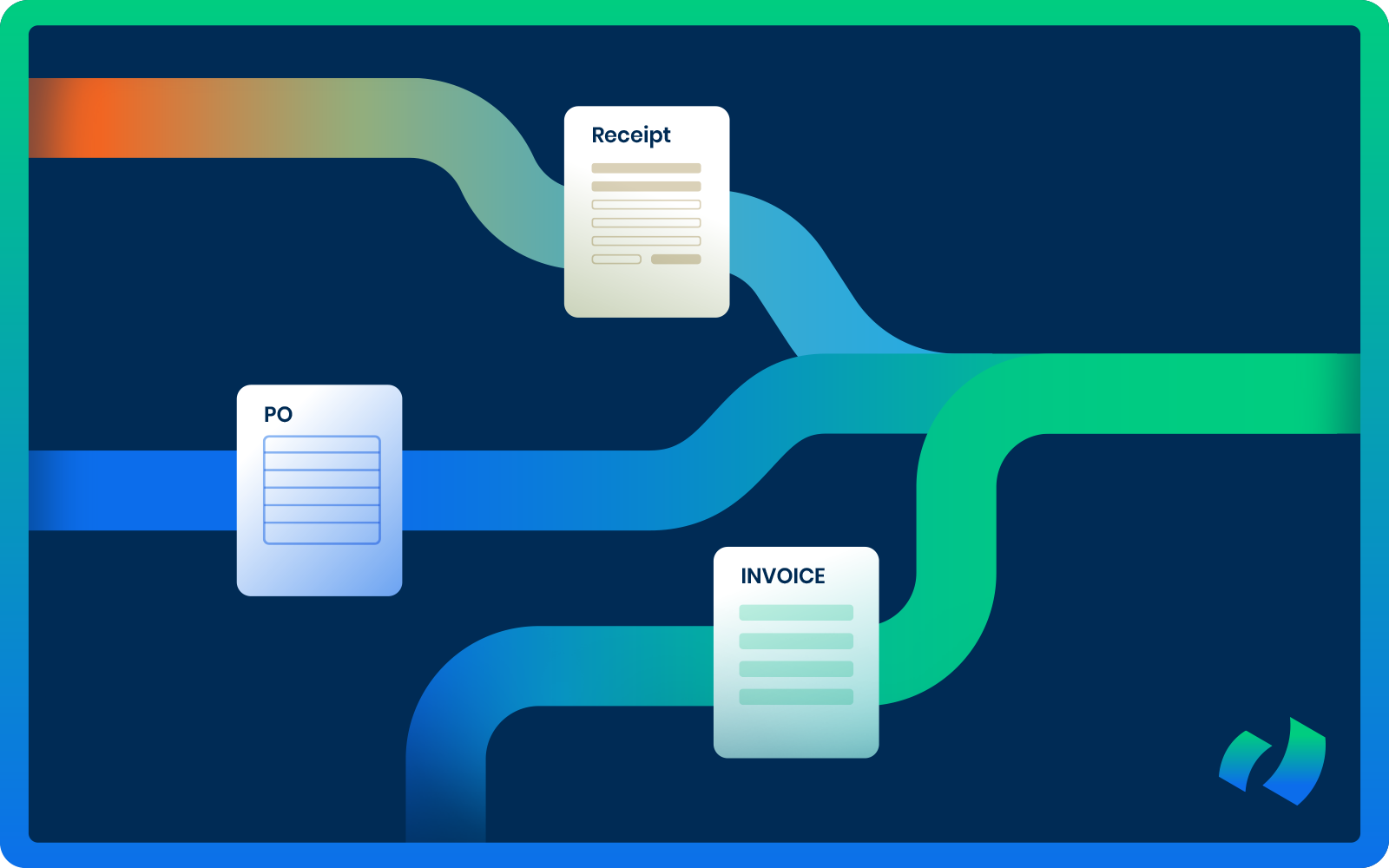Invoice matching software automates the process of comparing invoices to purchase orders and goods receipts, identifying discrepancies, and flagging exceptions for further review.
This software uses advanced technology to read and extract data from invoices, eliminating the need for manual data entry. It then cross-checks this information with corresponding purchase orders and receiving documents to ensure accuracy.
Some advanced invoice matching software, such as DOKKA, also include artificial intelligence (AI) capabilities. By using machine learning algorithms, these systems continuously improve accuracy and learn preferences for specific vendors or types of transactions. This not only speeds up the matching process but also enhances accuracy over time.
Why is Invoice Matching Important?
Invoice matching is the process of verifying that an invoice received from a vendor matches the related purchase order and goods receipt. This task is crucial because it ensures that businesses pay only for what they have received and agreed to in terms of pricing, quantity, and quality. Without efficient invoice matching processes in place, organizations risk making incorrect payments or overpaying vendors.
Moreover, accurate invoice matching plays a vital role in maintaining strong relationships with suppliers. When invoices are matched correctly and paid promptly, vendors are more likely to continue doing business with the organization. On the other hand, frequent errors or delays can lead to strained relationships, resulting in potentially higher costs and disruptions to the supply chain.
Types of Invoice Matching
There are typically three types of invoice matching:
- Two-Way Matching
- Three-Way Matching
- Four-Way Matching
Two-Way Matching
In 2-way matching, the invoice is matched against the purchase order to ensure consistency in details such as item descriptions, quantities, and prices. 2-way matching primarily checks that the invoiced amount and the ordered amount are the same. While this method helps in validating the purchase, it doesn’t account for the actual receipt of goods or services, making it less comprehensive than other methods.
Three-Way Matching
This more stringent approach involves matching the invoice against both the purchase order and the goods receipt. It confirms not only that the ordered items were received but also that they were billed correctly. This method helps in detecting discrepancies in the quantity received versus the quantity ordered and invoiced. 3-way matching provides a more thorough check, ensuring that the company pays only for what it has actually received.
Four-Way Matching
4-way matching adds an extra layer of verification by matching the invoice, purchase order, goods receipt, and inspection or acceptance document. This ensures that the goods or services have been inspected and accepted before payment is made. 4-way matching is the most comprehensive and is typically used for high-value purchases or critical supplies. It verifies the quality and condition of received goods, ensuring that they meet the required specifications before approving the invoice for payment.
The Challenges of Invoice Matching
The invoice matching process is riddled with potential challenges that can disrupt smooth operations. These challenges can significantly impact the efficiency and effectiveness of accounts payable functions:
- Volume and Complexity
Large organizations deal with thousands of invoices daily, each requiring careful review and matching. The sheer volume of transactions can overwhelm accounts payable teams, leading to backlogs and delays. Complex supply chains and multiple vendors further complicate the process, increasing the chances of errors and omissions.
- Human Error
Manual matching is prone to errors, from simple data entry mistakes to overlooked discrepancies. Human oversight can lead to incorrect payments or missed discrepancies, resulting in financial losses or strained supplier relationships. The repetitive and tedious nature of manual matching increases the likelihood of mistakes.
- Discrepancies
Invoices may not match purchase orders due to pricing errors, incorrect quantities, or unauthorized charges. These discrepancies can arise from clerical errors, changes in order quantities, or vendor billing mistakes. Resolving these discrepancies manually can be time-consuming and may require extensive communication with vendors, further delaying the payment process.
- Delays
Manual processes can be time-consuming, leading to delays in payments and potential cash flow issues. Slow invoice processing can affect a company’s ability to take advantage of early payment discounts and can damage relationships with key suppliers who rely on timely payments. Delays can also impact financial reporting and budgeting accuracy.
These challenges underscore the need for a more efficient and accurate approach to invoice matching. By automating the process, businesses can overcome these obstacles, ensuring that their accounts payable operations are streamlined, accurate, and efficient. Automated invoice matching software reduces the burden on accounts payable teams, allowing them to focus on strategic tasks and improving overall financial control.
How Does Invoice Matching Software Work?
The first step in invoice matching software is capturing the invoice data. This can be done through various methods, including scanning paper invoices or uploading electronic ones. The software then reads the relevant information, such as vendor, invoice number, and amount due. It also uses OCR to capture line item details like product descriptions and quantities.
Next, the software matches this data with corresponding purchase orders and receiving documents. It checks for discrepancies in terms of pricing, quantity, and other important details. If everything aligns, the invoice is deemed a match and can be processed for payment. If there are any discrepancies, the software flags them for further review by an accounts payable team member. Once these discrepancies are resolved, the invoice can be approved for payment.
As AI-powered software continues to learn from past transactions, it becomes more accurate and efficient at identifying and resolving discrepancies.
Benefits of Using Invoice Matching Software
Invoice matching software revolutionizes accounts payable operations by automating and optimizing the invoice verification process. By enhancing accuracy, efficiency, and compliance while fostering better supplier relationships and providing strategic insights, businesses can achieve significant improvements in financial management and operational effectiveness.
- Time and Cost Savings
By automating manual tasks such as data entry and document matching, invoice matching software saves time and reduces the need for additional headcount. This improvement in efficiency frees up resources for more strategic work and ultimately reduces costs.
- Increased Accuracy
Invoice matching software eliminates human error by automatically cross-checking data from different documents. This results in a higher level of accuracy and ensures that vendors are paid correctly for goods or services received.
- Faster Processing Time
With automated data extraction and cross-checking capabilities, invoice matching software reduces the time it takes to process invoices. This streamlines the payment process and helps businesses take advantage of early payment discounts.
- Improved Supplier Relationships
Timely and accurate payments foster stronger relationships with suppliers, leading to better terms, discounts, and improved overall supply chain management. This can also lead to better pricing and service from vendors in the long run.
- Better Financial Control
By automating the invoice matching process, businesses gain greater visibility into their accounts payable operations. This allows for more accurate budgeting and forecasting and improves financial control within the organization.
How to Choose the Right Invoice Matching Software
Selecting the right invoice matching software is crucial for optimizing accounts payable processes and achieving efficiency gains. Here are key considerations to guide your decision-making:
1) Identify Your Business Needs
Begin by assessing your specific requirements for invoice matching. Consider factors such as the volume of invoices processed daily, the complexity of your purchasing processes, and any unique compliance or integration requirements. Understanding your business needs will help prioritize features and functionalities in the software.
2) Compatibility and Integration
Ensure that the invoice matching software integrates seamlessly with your existing accounting systems, ERP (Enterprise Resource Planning) software, and other business applications. Compatibility is essential for smooth data exchange and workflow continuity across your organization.
3) Automation Capabilities
Look for software that offers robust automation capabilities, including OCR (Optical Character Recognition) for accurate data extraction, automated matching algorithms, and exception handling workflows. Automation reduces manual intervention, minimizes errors, and accelerates invoice processing times.
4) Accuracy and Matching Capabilities
Evaluate the software’s accuracy in matching invoices with purchase orders and goods receipts. Check if it supports two-way, three-way, or four-way matching processes according to your business needs. A reliable software should identify discrepancies promptly and facilitate quick resolution.
5) Scalability and Flexibility
Consider the scalability of the software to accommodate your business growth and fluctuating transaction volumes. Ensure that the software is flexible enough to adapt to evolving business requirements and can handle increased workload without compromising performance.
6) Reporting and Analytics
Choose software that provides comprehensive reporting and analytics capabilities. Insights into invoice processing metrics, vendor performance, and financial trends empower informed decision-making and strategic planning within your organization.
7) Security and Compliance
Prioritize software that adheres to industry standards for data security and compliance, such as GDPR (General Data Protection Regulation) or SOC (Service Organization Control) certifications. Robust security measures protect sensitive financial data and ensure regulatory compliance.
8) User Interface and Ease of Use
Consider the software’s user interface (UI) and ease of use for accounts payable teams. Intuitive navigation, customizable dashboards, and role-based access control enhance user experience and productivity. Evaluate the training requirements for adopting the software.
9) Customer Support and Service
Evaluate the vendor’s reputation for customer support and service quality. Ensure they provide responsive technical support, training resources, and regular software updates to address any issues or evolving business needs.
10) Cost and Return on Investment (ROI)
Finally, assess the total cost of ownership, including initial setup fees, licensing costs, and ongoing maintenance expenses. Calculate the potential ROI based on anticipated time savings, reduced errors, and improved operational efficiency gained from implementing the software.
By carefully considering these factors, you can confidently select the right invoice matching software that aligns with your business objectives and enhances your accounts payable processes effectively. Choose a solution that not only meets your current needs but also supports your organization’s growth and future success.







